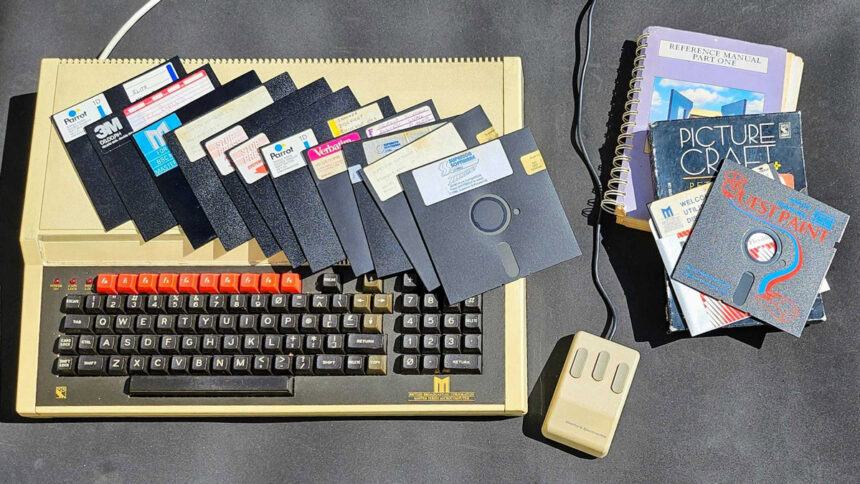
Above: The author’s BBC Master 128 “microcomputer”, 1986, with its unique “mouse” input device.
The allure of looking back at technology’s past is undeniable. The technology we use every day doesn’t exist in a vacuum. It wasn’t created spontaneously, but rather built on the accumulated knowledge, ideas, and hopes of previous generations. It’s no wonder that a community exists dedicated to celebrating and exploring nearly every aspect of technology’s complicated past.
Technology has been a lifelong interest for me, starting with a BBC Micro Model B microcomputer that my dad brought home for me to play with one weekend. When my dad saw how much I liked the BBC, we bought the Micro’s successor, the BBC Master 128, and by the age of six, I was creating my own world in BASIC. I even started a school newspaper using crude desktop publishing software and a special hardware device called a “mouse” to make it easier to operate. I still remember the smell of the “computer room” where I spent countless days at the keyboard as a child. My craving for newer, more powerful equipment soon led me down the path of PCs, but I still own and cherish that rare 1986 machine.
I currently have a large collection of computer devices from the same era that I never had a chance to experience in their heyday. The Amiga 1000 is a gem among them, allowing me to explore a completely different Motorola 68000-based history parallel to my own 6502 to x86 path. Last winter, I took a holiday and immersed myself in the Amiga world, refusing to use a modern PC and spending all my time learning the OS and how to develop in Aztec C, reading documentation and how-to guides from that time. By essentially cosplaying as a 1989 Amiga user, I was able to get a fascinating taste of the new technology that I missed the first time around.


But I didn’t do it alone. My Amiga journey was facilitated by an emulation and connectivity package provided by an Italian group, in addition to the excellent paper books I inherited. Bomb JackAnd when one of my Aztec C disks broke, I found a replacement image in the BS1 disk archive of a Belgian Amiga club. Locally, I share my passion for Amiga and other old hardware through monthly meetups at a local maker space, All Hands Active. My quest has been immeasurably strengthened by the passionate community from around the world that has formed around this wonderful old gear.
From local computer clubs like those in Palo Alto, where Steve Wozniak launched the first Apple Computer, to trade shows like those in London, where I witnessed the launch of Archimedes, the ARM2-powered successor to the BBC Micro, technology has always been born from and sustained by these communities. Technology has enabled new forms of community, such as bulletin board systems (BBS), CompuServe, IRC, modern forums, and other digital meeting places that allow enthusiasts to connect more easily regardless of geography.




Museums like Mountain View’s Computer History Museum and Maryland’s Bloop Museum provide context, depth, and even the chance to get your hands on retro gear and experience what makes it special; digital libraries like the Internet Archive and WinWorld put lesser-known titles in your hands that might otherwise be locked away on a dusty floppy disk somewhere; and in-person events like the Vintage Computer Festival and our Maker Faire allow enthusiasts to share their passions or discover new ones.
Maybe you’re interested in restoring obscure old computers, enhancing them with powerful new hardware, and embracing their limitations to create cool 8-bit chiptunes, irresistible tracker music, or evocative demos. Or maybe you prefer to play “outdated” music formats, niche video games from the 80s and 90s, or hack old ROMs to put your own spin on classic games. The emerging “fantasy console” scene even lets you create games for retro-style consoles that never existed before. Whatever your obsession with retro technology, there’s a community out there for you.
Retro themed make: (this is printing or PDF Maker Shed’s “Game Boy” covers beloved retro consoles like my Game Boy on the cover, as well as the chiptune music scene (“Pro-Sound Mod”, page 34) and the community embracing the Game Boy Camera and homebrew game development (“Game Boy Camera Renaissance”, page 28). The music theme continues with a deep dive into Raspberry Pi Pico-based Game Boy development. PC Sound Card Emulator PicoGUS (page 46), and an article on DIY vinyl records (page 38) tell the stories of makers we met at Maker Faire Bay Area who are finding new and fun ways to explore this century-old technology. Retro gamers can build full-size or mini stand-up arcade consoles (“DIY Retro Arcades,” page 50) and brighten up their gaming rooms with Mario villains (“Scary Wall Sconces,” page 80). Our investigation into the recent NABU boom (“Something Old, Something New,” page 44) proves that even strange old tech that nobody is nostalgic for can inspire passionate new communities. And our capacitor-swapping skill builder (page 118) imparts valuable repair techniques for retro enthusiasts.
The PICO-8 fantasy console, the FPGA-powered Analogue Pocket handheld emulator, and the Clockwork Pi uConsole ( make: Vol.88(Review page 126) lets you experience the charm of the past without sacrificing the convenience of modern devices. The future of retro is bright.
Retro Playlist
In putting together this section, we asked contributors to share their favorite chiptunes and other retro-oriented songs. I put them together in a playlistYou can jam along as you explore the sections.
of Bloop Museum is an electronic entertainment museum dedicated to computers, games, media, and gadgets. With over 20,000 artifacts, it has outgrown its current space and is seeking funding to move to a permanent location. You can help with donations. Donation page.
This article is make: Vol.89.







